How Does a Diaphragm Pump Work?
Diaphragm Pumps are used extensively in many industries and can handle a very wide variety of liquids. Diaphragm Pumps are in the category of "positive displacement" pumps because their flowrates do not vary much with the discharge "head" (or pressure) the pump is working against (for a given pump speed). Diaphragm Pumps can transfer liquids with low, medium or high viscosities and also liquids with a large solids content. They can also handle many aggressive chemicals such as acids because they can be constructed with a wide variety of body materials and diaphragms.
 by Tom Hansen, P.E. | ©Dultmeier Sales
by Tom Hansen, P.E. | ©Dultmeier Sales
Air-Operated Diaphragm Pumps
The most popular type of diaphragm pump is the Air-Operated Diaphragm Pump. These pumps use compressed air as their power supply. They also include two chambers with a diaphragm, inlet check valve and outlet check valve in each chamber. The air supply is shifted from one chamber to another with an air spool valve that is built into the pump. This continual shifting of air from one chamber to another (to the backside of the diaphragm) forces liquid out of one chamber and into the discharge piping while the other chamber is being filled with liquid. There is some pulsation of discharge flow in Air-Operated Diaphragm Pumps. This pulsating flow can be reduced somewhat by using pulsation dampeners in the discharge piping. Dultmeier Sales offers Air-Operated Diaphragm Pumps from a variety of manufacturers including those listed below in 1/4" to 4" sizes for small or high flowrates.
Small Air-Operated Diaphragm Pumps
These pumps typically have 3/8", 1/2" or 3/4" inlet and outlet ports and flowrates of 2 to 10 GPM.
Small Motor Driven Diaphragm Pumps (12, 24 or 115 Volt)
These diaphragm pumps usually have 3/8", 1/2" or 3/4" inlet and outlet ports and flowrates from 1 to 7 GPM. They typically develop pressures to 60 PSI and even 100 PSI in some cases. These small, motor-driven diaphragm pumps are made in two distinct styles. The first is the "Demand" Style which includes a built-in pressure switch to automatically stop and start the pump at specific pressure settings; this style is the most popular. The other one is the "By-Pass" Style where the pump continues to run regardless of pressure in the system but internally bypasses flow if the discharge valve is closed. However, if the discharge valve is closed for more than a minute or two, overheating of the liquid can occur and damage the pump internals.
Engine or Motor Driven (Shaft Driven) Diaphragm Pumps
Larger shaft-driven diaphragm pumps that can be driven from engines or motors are also very popular for high pressure tree spraying and lawn spraying (up to 725 PSI). Some models of these pumps can also provide higher flowrates up to 30, 40 or even 60 GPM. Models are available to run at 550 RPM with 6:1 Gear-Reduction Engines and other models include built-in gear reduction units in order to run with standard 3600 RPM engines. Pressure control units are also available for all models.
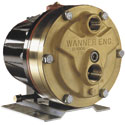
Yet another type of larger shaft-driven diaphragm pump is the Wanner Hydra-Cell Pump. These pumps will provide pressures to 1500 PSI or even 2500 PSI and flowrates to 36 GPM. They can also be manufactured with a variety of metals and elastomers for aggressive chemicals, acidic solutions, wettable powders, slurries, abrasives and hot liquids.
© Copyright Dultmeier Sales, LLC this material cannot be utilized in any way including on other websites or publications without the express written permission of Dultmeier Sales.








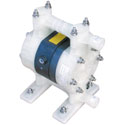
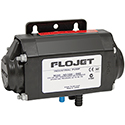
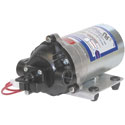
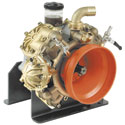
 Shurflo Pumps
Shurflo Pumps  Yamada Pumps
Yamada Pumps  Flojet Pumps
Flojet Pumps  Graco Pumps
Graco Pumps  Sotera Pumps
Sotera Pumps  Versa-Matic Pumps
Versa-Matic Pumps  CDS John Blue Pumps
CDS John Blue Pumps  Remco Pumps
Remco Pumps  Warren Rupp Pumps
Warren Rupp Pumps  Hypro Pumps
Hypro Pumps  Udor Pumps
Udor Pumps 

